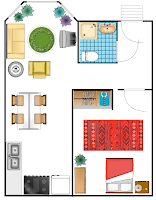
This is possibly one of the coolest resources that I've come upon. The Newseum, "— a 250,000-square-foot museum of news — offers visitors an experience that blends five centuries of news history with up-to-the-second technology and hands-on exhibits."
In addition to its physical presence, the Newseum has a home in cyberspace at: http://www.newseum.org/ This information-packed website includes virtual versions of its permanent physical exhibits including Pulitzer Prize-winning photographs; a 9/11 gallery; Berlin Wall gallery; and a Journalists Memorial.
The gallery that I found the most fascinating is the Today's Front Pages Gallery:
Front Pages From Across America and Around the World. Here's the description from the Newseum's website: "More than 700 newspapers transmit their front pages electronically
to the Newseum every day. Up to 80 are enlarged and printed for display
in this gallery — among them one from every state and the District of Columbia
as well as a sampling of international newspapers. Additional front pages
are displayed outside the Newseum on Pennsylvania Avenue."
Front Pages From Across America and Around the World. Here's the description from the Newseum's website: "More than 700 newspapers transmit their front pages electronically
to the Newseum every day. Up to 80 are enlarged and printed for display
in this gallery — among them one from every state and the District of Columbia
as well as a sampling of international newspapers. Additional front pages
are displayed outside the Newseum on Pennsylvania Avenue."
One can access this gallery online at: http://www.newseum.org/todaysfrontpages/
More than 700 newspapers from around the world electronically submit their front pages on a daily basis. 10 are chosen for a "Top Ten" each day, but visitors to the site can access the front pages via list or map. As a neat bonus, each front page is available as a PDF, allowing one to enlarge and read the stories. A link to each newspaper's website is provided, as well.
This is obviously not the best way of getting a complete "news fix" each day, but that isn't the point; rather, as the site states: "This daily exhibit is part of the Newseum's mission to promote better public understanding of news and journalism. A front page can reveal as much about a newspaper and its community as it does about the day's news. Some days, one story dominates these front pages. But often the stories on page one reflect communities with different interests."
Fascinating!
Kimberley Barker
